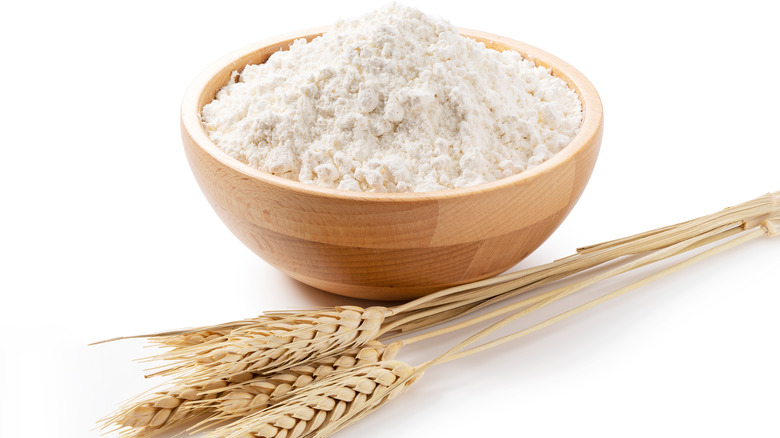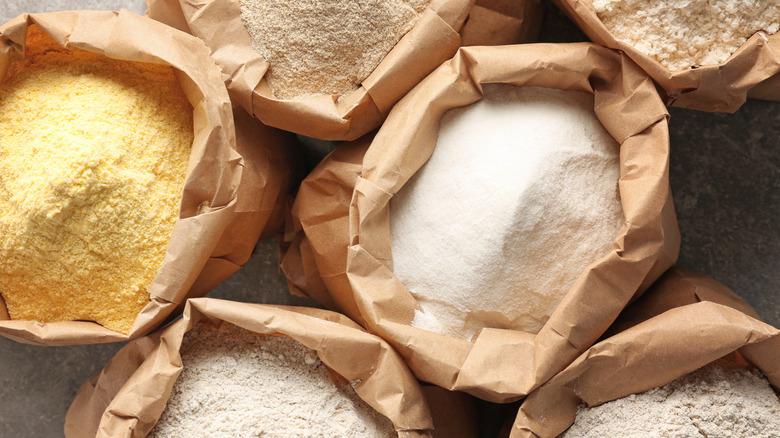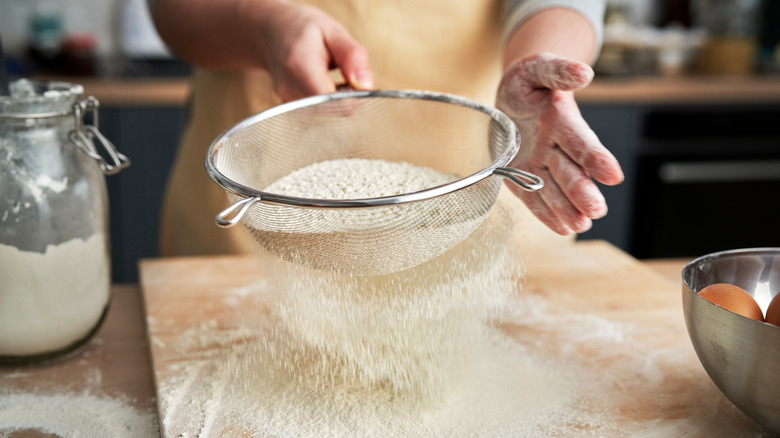The Simple Method To Remember For Substituting Cake Flour
If you aren't an experienced baker, you may be confused when coming across a recipe that calls for cake flour. And while it may seem logical that cake flour is used only to make cakes, that simply isn't true, as there are different types of flour you use depending on the type of recipe you're making.
While all-purpose flour can be used, logically enough, to make just about any baking recipe, there are some recipes that need a lighter touch. Most that call for cake flour are for soft and fluffy cakes, delicate cookies, muffins, biscuits, tender quick breads, and even pancakes. And, of course, there are several different kinds of flour used in baking, from bread flour to semolina flour to whole wheat flour to pastry flour.
So, what is cake flour? Where can you find it? Is there a simple method when substituting for it? And why is it different? To understand why cake flour is sometimes a better choice, we need to learn about flour. This versatile powder is made from wheat grains that are combinations of protein and starch. And it's the protein that's key.
Discovering protein levels in flour
Two proteins in flour, glutenin and gliadin, react with liquid to form gluten, per King Arthur Flour, which creates a strong web that forms the structure of any baked good.
For the right balance of gluten and starch, millers use two types of wheat: hard and soft, according to Nash's Organic Produce. Hard wheat has more gluten and less starch, while the soft variety has more starch and less gluten. Per Wheat Foods Council, all-purpose flour is a blend of hard and soft wheat, with a protein content of about 8% to 11%. Meanwhile, bread flour is a blend of hard wheat and has a protein content of 12% to 14%. Cake flour is made from soft wheat, with the lowest protein content of 7% to 9%.
The lower protein content in cake flour means there's less gluten to form webs in your cakes or muffins. In other words, you'll enjoy or serve a more tender product. And while grinding soft wheat is one way to get cake flour, you can make your own; just add some starch to all-purpose flour to lower the protein content and interrupt gluten formation.
You may also be asking, "What's a simple method for substituting for cake flour?" Using cornstarch! For every cup of cake flour, insert two tablespoons of cornstarch into a measuring cup (via Food Network). Then, lightly spoon in enough flour to fill the cup, level off the top, and sift the mixture to combine them.
Making your own cake flour
While buying cake flour is no problem, you can also make a larger quantity of your own and store it. Just use the same proportions for a smaller amount. For instance, if you want to make six cups of cake flour, combine 3/4 cup of cornstarch in a sifter with 5-1/4 cups of all-purpose flour. Sift twice to evenly distribute the cornstarch in the flour. Because sifting also adds air to this powder, you'll end up with a little more than six cups. That's okay — just measure carefully when using your homemade cake flour, per Sugar Spun Run.
As with all flours, make sure to store them in an airtight container; any glass jar or plastic container with a tight-fitting lid will do. Whether you buy or make your own, it's a good idea to make a label identifying the flour, with the date you made it, and tape it onto the container so you know what you have. All flours look remarkably alike!
Now you're ready to make some ethereal recipes. Try breath o'spring cake (even in the middle of winter), lost-and-found lemon pound cake, hurry-up caramel cake, or the ultimate vanilla cupcake. You can also use cake flour to make the best chewy chocolate chip cookies or Seersucker's buttermilk biscuits, or the sublime angel food cupcakes with raspberry buttercream.


